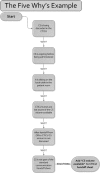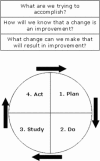Quality improvement methodologies increase autologous blood product administration
- PMID: 24783313
- PMCID: PMC4557510
Quality improvement methodologies increase autologous blood product administration
Abstract
Whole blood from the heart-lung (bypass) machine may be processed through a cell salvaging device (i.e., cell saver [CS]) and subsequently administered to the patient during cardiac surgery. It was determined at our institution that CS volume was being discarded. A multidisciplinary team consisting of anesthesiologists, perfusionists, intensive care physicians, quality improvement (QI) professionals, and bedside nurses met to determine the challenges surrounding autologous blood delivery in its entirety. A review of cardiac surgery patients' charts (n = 21) was conducted for analysis of CS waste. After identification of practices that were leading to CS waste, interventions were designed and implemented. Fishbone diagram, key driver diagram, Plan-Do-Study-Act (PDSA) cycles, and data collection forms were used throughout this QI process to track and guide progress regarding CS waste. Of patients under 6 kg (n = 5), 80% had wasted CS blood before interventions, whereas those patients larger than 36 kg (n = 8) had 25% wasted CS before interventions. Seventy-five percent of patients under 6 kg who had wasted CS blood received packed red blood cell transfusions in the cardiothoracic intensive care unit within 24 hours of their operation. After data collection and didactic education sessions (PDSA Cycle I), CS blood volume waste was reduced to 5% in all patients. Identification and analysis of the root cause followed by implementation of education, training, and management of change (PDSA Cycle II) resulted in successful use of 100% of all CS blood volume.
Conflict of interest statement
The senior author has stated that the authors have reported no material, financial, or other relationship with any healthcare-related business or other entity whose products or services are discussed in this paper.
Figures








References
-
- Institute of Medicine, Committee on Quality of Health Care in America. Crossing the Quality Chasm: A New Health System for the 21st Century. Washington, DC: National Academies Press; 2001.
-
- Varkey P, Reller K, Resar R.. Basics of quality improvement in health care. Mayo Clin Proc. 2007;82:735–739. - PubMed
-
- Berwick D.. Continuous improvement as an ideal in health care. N Engl J Med. 1989;320:53–56. - PubMed
-
- Berwick D.. Quality comes home. Ann Intern Med. 1996;125:839–843. - PubMed
MeSH terms
LinkOut - more resources
Full Text Sources
Medical
Miscellaneous
